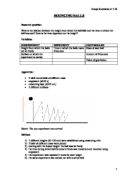The equipments I want to use would be different kind of balls with different masses, an instrument that can measure the velocity of the bouncing ball, an apparatus that can hold and drop the ball from the same height every time, a weight and a ruler.
The method to do this experiment is to drop different balls at the same height. I need to drop the balls with different masses and than I will measure the velocity using data logger. I will use three different balls with different masses and drop it five teams to get sufficient data.
Figure 1
Figure 2
Figure 1 shows the balls I used. From the left it is a ping pong ball, an elastic ball and a golf ball. Figure 2 shows the data logger instrument I used. The one to the left is connected to the computer and the other one to the right is put on the roof pointing downwards. So the circle on that instrument is measuring the velocity.
Data and analysis
The ball was dropped from the same spot, which has a height of about 2m 0.1m
By following my method, I gained the data in this table.
The mass in the balls are measured using a weight. The weight is quite accurate so I estimate the uncertainty to be 0.2. The uncertainty in velocity can be found by finding the difference in the largest and smallest velocity for each ball. Which is 0.38msec-1, 0.27msec-1 and 0.30msec-1. The average of these ranges is 0.32, so half the range is 0.16 msec-1. However, this uncertainty is too precise so I would the uncertainty is 0.20 msec-1.
Now I will proceed finding the averages to put the values into a graph.
There is no average for mass, because it is measured with an accurate weight so I will keep the estimated uncertainty of 0.2g.
The average in velocity can be found by using this formula and calculate it on a calculator. I will keep the uncertainty due to the variation of measured values.
Now I will use these values and try to make a graph of it with velocity against mass.
The graphs show the best straight-line gradient, the max gradient is and the min gradient is.
The range of gradient is:
Half the range of gradient, I find the uncertainty in the best straight line
,
which means a gradient with an uncertainty of
The uncertainty dividing with the gradient, multiply that value with 100 I get a percentage error of about 105%, and this is not reasonable at all. So, I will evaluate this large uncertainty in my evaluation at the end and continue adjusting my graph to get an offset point for both velocity and mass to be 0(origin).
I tried different regression on my calculator and found the logarithm regression having an offset closest to 0(origin).
This graph looks not good. It has a correlation of 0.512 which is really bad. Maybe it has something to do with my huge uncertainty calculated earlier. So I don’t know if I have a good result. Let me evaluate and conclude it in my conclusion.
Conclusion and evaluation
To evaluate my result I have to look into the uncertainty and the result. The uncertainty I found was 105% which is very suspicious. It should not be possible, so there has to be reason for this error.
My idea proposed that mass and velocity is proportional to each other. However, my result did not show that proposal. Maybe I should have tried another ball instead of a light ping pong ball of 3 g. This may have influenced the error.
So neglecting my large uncertainty, I found the logarithmic graph to show the best model of the relationship between velocity and mass. Which means my idea of mass and velocity to be proportional is wrong.
To improve my experiment, I could have tried to use more balls with different masses to get a wider data. Maybe I should have measured the velocity of the ball after it bounces and also using a mechanical release to drop the ball.







